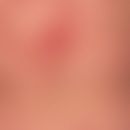DefinitionThis section has been translated automatically.
Half-lifeThis section has been translated automatically.
You might also be interested in
Pharmacodynamics (Effect)This section has been translated automatically.
Schizontocidal by interference with plasmodial DNA; killing of erythrocytic forms in all stages of development; no effect on tissue forms in the liver (malaria tertiana and quartana).
Anti-inflammatory by stabilizing lysosomal membrane, inhibiting chemotaxis of neutrophils and eosinophils.
Immunosuppressive, inhibition of DNA synthesis as well as formation of UV-induced thymidine dimers, accumulation in pigment-forming cells (cause of ophthalmological complications), inhibition of skin UV absorption.
In cutaneous lupus erythematosus, chloroquine leads to the reduction of HLA-DR+/CD1a+ cells in lesional skin!
IndicationThis section has been translated automatically.
Limited indicationThis section has been translated automatically.
Dosage and method of useThis section has been translated automatically.
- Malaria therapy: Initially 0.6 g chloroquin base/day p.o., then after 6, 24 and 48 hours 0.3 g chloroquin base each.
- Malaria prophylaxis: 0.3 g every 7 days during the risk of infection and 4-8 weeks afterwards.
- Lupus erythematosus and rheumatoid arthritis: 250 mg/day, reduction depending on the findings.
- Reticular erythematous mucinosis: 250 mg/day for 4 weeks, 125 mg/day for another 4 weeks, then further creeping.
- Porphyria cutanea tarda: 125 mg 3 times/week.
Remember! Before starting therapy, determine the glucose-6-phosphate dehydrogenase level. Women of childbearing age must have a negative pregnancy test before therapy and effective contraception protection must be provided during and up to 3 months after therapy (risk-benefit ratio in malaria prophylaxis and therapy, since malaria infection itself causes damage to the fetus)!
Undesirable effectsThis section has been translated automatically.
Accommodation disorders, irreversible retinopathy, blood count disorders, gastrointestinal disorders, allergic reactions, exacerbation of a psoriasis vulgaris or porphyria cutanea tarda, headache, dizziness, myopathy, leukopenia, agranulocytosis, stomach upset, headache, dizziness, exanthema, bluish discoloration of the skin, nail pigmentation, hearing loss, corneal damage.
Chloroquine can cause life-threatening torsade de poin arrhythmias.
Notice! With long-term therapy the risk of retinopathy is increased with 100 g Chloroquinbase and more, corresponding to a 2-year therapy with 250 mg/day. Therefore, regular ophthalmological check-ups in 3-month intervals are recommended!
InteractionsThis section has been translated automatically.
Chloroquine is a substrate of CYP2C8 and CYPP3A4 and a medium strength inhibitor of CYP2D6. Leflunomide inhibits CYP2C8 via its teriflunomide, which allows chloroquine plasma levels to rise.
ContraindicationThis section has been translated automatically.
PreparationsThis section has been translated automatically.
Notice! Patient information: The intake should take place after meals!
TablesThis section has been translated automatically.
Significant interactions of chloroquine
Alcohol |
Liver damage |
Ampicillin |
Resorption of ampicillin ↓ |
Basic therapeutics |
Rate of side effects ↑ |
Cimetidine |
Excretion of the chloroquine ↓ |
Digoxin |
Digoxin plasma levels ↑ |
Glucocorticoids |
BB alterations, cardiomyopathy, myopathies |
Indomethacin |
Retinopathy risk ↑ |
Mefloquine |
Seizures |
Metronidazole |
acute dystonic response |
Phenylbutazone |
Risk of exfoliative dermatitis ↑ |
Probenecid |
Risk of sensitisation ↑ |
pyrimethamine/sulfadoxine |
Risk of severe skin reactions ↑ |





